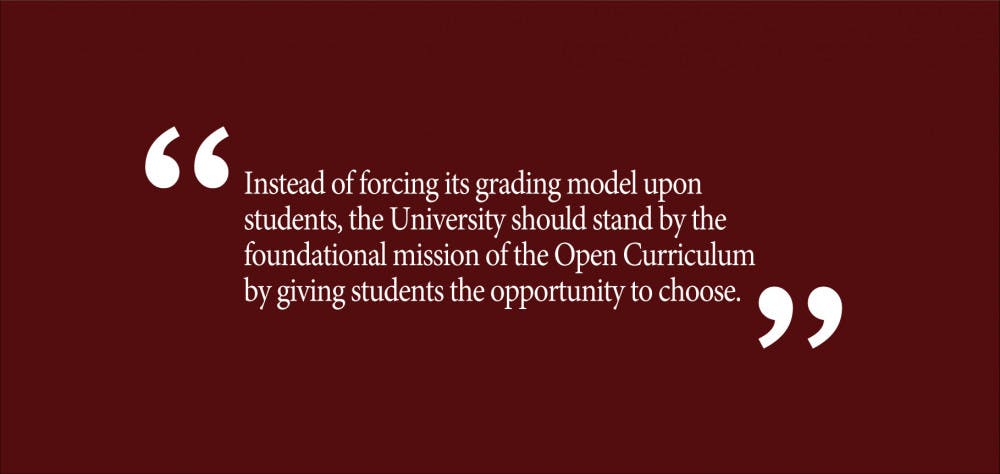The purpose of Brown’s Open Curriculum is to let students choose how to design their education. As a part of this curriculum, students can choose to take courses Satisfactory or No Credit if they want to explore a course out of their comfort zone. Yet, there is one important area in which Brown fails to live up to its ideal of prioritizing student choice. Many of the “creative” courses, particularly in the visual and literary arts, have mandatory S/NC grading. This problem is most egregious in the Visual Art Department, which, as a rule, makes the grading system for all of its courses mandatory S/NC.
The University’s policy not to allow students to take creative courses for a grade is problematic for three reasons: it is based on the condescending assumption that art cannot have any standards or rigor; it devalues the hard work that artists do in those classes and potentially creates a negative classroom environment; and it places students at a disadvantage when pursuing their post-graduate plans.
Creative courses at Brown likely include a mandatory S/NC grading model out of the University’s desire to foster creativity, under the assumption that art cannot be critically evaluated. The intention to allow art students room for exploration and creativity without fear of a grade is of course understandable. Unlike many disciplines, art is subjective, and in an ultimate sense, there are no correct answers in art.
But subjectivity does not mean that art must lack standards. To assert that art has no measures to assess quality is to dismiss all the knowledge and expertise of professors in the creative arts. These professors have broad knowledge of many artistic styles as well as specialized knowledge of particular artistic fields. They should be trusted to evaluate and critique students’ work. Even when a student deviates from conventional styles or from the preferred style of the professor, the professor is still in the position to evaluate the student’s technique and effort in a rigorous manner. Many kinds of academic work, such as essays, lend themselves to a degree of subjectivity. Just as a history professor still grades an essay despite its subjectivity, art professors should be able to evaluate students’ work rigorously while still leaving room for creativity. As a frustrated VISA concentrator Sylvia Atwood puts it, “The argument that art cannot be measured is a reflection of a society in denial of the fact that art requires as much hard work and critical thinking as any other discipline.”
Of course, weighing the quality of a painting is still a more subjective process than grading the argument in a history essay. It is therefore understandable that some students should not want their art to be graded. But even if the University removed the S/NC requirement for creative courses, these students still have the option to take the course S/NC. If the University really wants to emphasize the subjectivity of art, it could publicize recommendations that students take art courses S/NC. But it should not force them to do so.
Many students in art courses have seemingly internalized the University’s message that art cannot be rigorous by often cutting class, not completing assignments and being inattentive during class. It is deeply unfair for students who put care and effort into their work to be graded on the same binary scale as those who don’t take the course seriously. In theory, professors could ‘NC’ these students, but in practice they are unlikely to take such a drastic measure, especially in the more subjective disciplines. So students putting genuine thought and time into projects can receive the same grade as students who take advantage of art’s subjectivity by putting little effort into their work. The purpose of allowing grades would not be to punish the less-engaged students, but only to acknowledge the efforts of the more-engaged students and to encourage an environment in which students are more likely to take art seriously.
In an ideal world, education would not have to be constrained by grading. But like it or not, society still values quantifiable metrics of success, and therefore many students do too. Artistic disciplines should not be singled out as the one area where these metrics are irrelevant. It is not fair to students who value these metrics of success to be told that their art courses are the “easy” course because they are ungraded.
While the University may claim to support the arts, it is actually making its arts students less competitive after graduation. Art students who need grades on their transcripts feel obligated to prioritize their non-artistic disciplines. This problem is exasperated by the fact that other art programs do grade student work. Rhode Island School of Design, the country’s premier art school, has a rigorous system of grading for their students’ work. In not giving the option of letter grades, the University ignores the full potential of its art students and fails to provide everything they require from their education to be ready for the world after graduation.
If Brown University wants to better support its student artists, it should listen to their qualms regarding mandatory S/NC grading. Instead of forcing its grading model upon students, the University should stand by the foundational mission of the Open Curriculum by giving students the opportunity to choose. If you believe the University should consider removing the S/NC requirement, sign onto this petition made by Atwood.
Alisa Caira ’22 can be reached at alisa_caira@brown.edu. Please send responses to this opinion to letters@browndailyherald.com and op-eds to opinions@browndailyherald.com.





